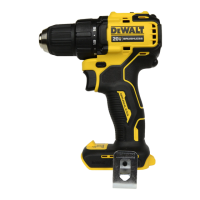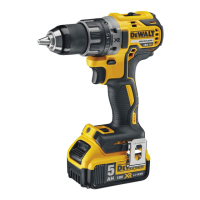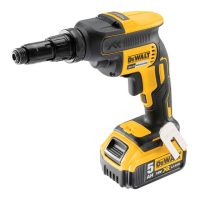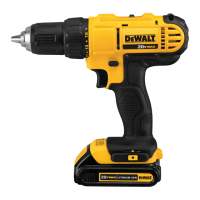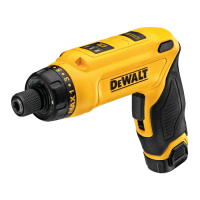6
ENGLISH
Chargers
DeWALT chargers require no adjustment and are designed to be
as easy as possible tooperate.
Electrical Safety
The electric motor has been designed for one voltage only.
Always check that the battery pack voltage corresponds to the
voltage on the rating plate. Also make sure that the voltage of
your charger corresponds to that of yourmains.
i
Your DeWALT charger is double insulated in
accordance with EN60335; therefore, no earth wire
isrequired.
If the supply cord is damaged, it must be replaced only by
DeWALT or an authorised serviceorganisation.
Mains Plug Replacement
(U.K.& Ireland Only)
If a new mains plug needs to be fitted:
• Safely dispose of the oldplug.
• Connect the brown lead to the live terminal in theplug.
• Connect the blue lead to the neutralterminal.
WARNING: No connection is to be made to the
earthterminal.
Follow the fitting instructions supplied with good quality plugs.
Recommended fuse: 3A.
Using an Extension Cable
An extension cord should not be used unless absolutely
necessary. Use an approved extension cable suitable for the
power input of your charger (refer to Technical Data). The
minimum conductor size is 1mm
2
; the maximum length is30m.
When using a cable reel, always unwind the cablecompletely.
Residual Risks
The following risks are inherent to the use of drills:
• Injuries caused by touching the rotating parts or hot parts of
thetool.
In spite of the application of the relevant safety regulations
and the implementation of safety devices, certain residual risks
cannot be avoided. These are:
• Impairment ofhearing.
• Risk of squeezing fingers when changingaccessories.
• Health hazards caused by breathing dust developed when
working inwood.
• Risk of personal injury due to flyingparticles.
• Risk of personal injury due to prolongeduse.
• Do not operate this tool for long periods of time.
Vibration caused by hammer action may be harmful to your
hands and arms. Use gloves to provide extra cushion and limit
exposure by taking frequent restperiods.
• Air vents often cover moving parts and should be
avoided. Loose clothes, jewellery or long hair can be caught
in movingparts.
Drill Safety Warnings
Safety Instructions for All Operations
• Wear ear protectors when impact drilling. Exposure to
noise can cause hearingloss.
• Hold the power tool by insulated gripping surfaces when
performing an operation where the cutting accessory or
fasteners may contact hidden wiring. Cutting accessory
or fasteners contacting a “live” wire may make exposed metal
parts of the power tool “live” and could give the operator an
electricshock.
Safety Instructions When Using Long
DrillBits
• Never operate at higher speed than the maximum
speed rating of the drill bit. At higher speeds, the bit is likely
to bend if allowed to rotate freely without contacting the
workpiece, resulting in personalinjury.
• Always start drilling at low speed and with the bit tip
in contact with the workpiece. At higher speeds, the bit is
likely to bend if allowed to rotate freely without contacting the
workpiece, resulting in personalinjury.
• Apply pressure only in direct line with the bit and do not
apply excessive pressure. Bits can bend causing breakage or
loss of control, resulting in personalinjury.
Additional Specific Safety Rules for Drills/
Drivers/Impact Drills
• Use clamps or other practical way to secure and support
the workpiece to a stable platform. Holding the work by
hand or against your body is unstable and may lead to loss
ofcontrol.
• Wear safety goggles or other eye protection. Hammering
and drilling operations cause chips to fly. Flying particles can
cause permanent eyedamage.
• Drill bits and tools get hot during operation. Wear gloves
when touchingthem.
unpredictable behaviour resulting in fire, explosion or risk
ofinjury.
f ) Do not expose a battery pack or tool to fire or
excessive temperature. Exposure to fire or temperature
above 130°C may causeexplosion.
g ) Follow all charging instructions and do not charge
the battery pack or tool outside the temperature
range specified in the instructions. Charging
improperly or at temperatures outside the specified range
may damage the battery and increase the risk offire.
6) Service
a ) Have your power tool serviced by a qualified repair
person using only identical replacement parts. This
will ensure that the safety of the power tool ismaintained.
b ) Never service damaged battery packs. Service
of battery packs should only be performed by the
manufacturer or authorised serviceproviders.

